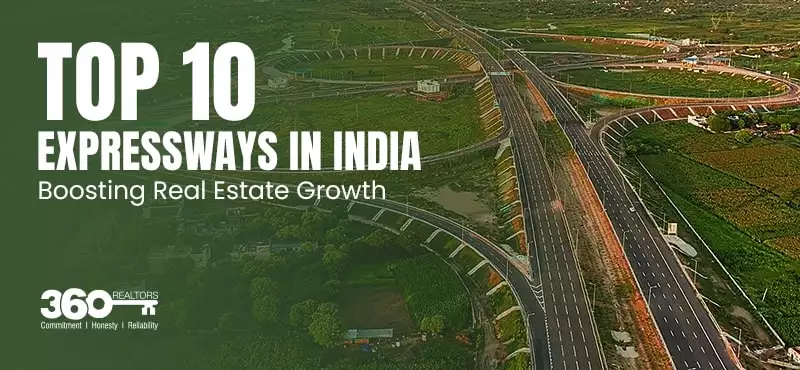How High-Speed Corridors Are Transforming Property MarketsIndia’s expressway network is not just revolutionizing transportation—it’s reshaping the real estate landscape. These high-speed corridors are unlocking economic potential, reducing travel times, and fueling demand for residential, commercial, and industrial properties in previously underserved regions. Below, we explore the top 10 expressways driving real estate growth and their transformative impact.
1. Yamuna Expressway
- Route: Greater Noida (NCR) to Agra, Uttar Pradesh
- Length: 165 km
- Impact: This expressway has spurred massive residential and industrial development, including townships like Noida Extension and commercial hubs near the upcoming Jewar Airport. Property prices have surged by 30–40% since its inauguration213.
- Key Features: Proximity to the Taj Mahal and upcoming Formula 1 racing circuits.

Read Also 9 Best Real Estate Investments For Beginners In 2025
2. Mumbai-Pune Expressway
- Route: Mumbai to Pune, Maharashtra
- Length: 94.5 km
- Impact: India’s first six-lane expressway has transformed the Mumbai-Pune corridor into a hotspot for luxury apartments, IT parks, and weekend homes. Areas like Lonavala and Khopoli have seen 25% annual price appreciation213.
- Key Features: Scenic Western Ghats views and reduced travel time (2–3 hours).
3. Delhi-Meerut Expressway
- Route: Delhi to Meerut, Uttar Pradesh
- Length: 96 km
- Impact: Reduced commute times (45 minutes) have made Meerut a satellite city for Delhi workers. Affordable housing projects along the route are in high demand213.
- Key Features: Segregated lanes for non-motorized transport and smart traffic management.
4. Purvanchal Expressway
- Route: Lucknow to Ghazipur, Uttar Pradesh
- Length: 340 km
- Impact: Connecting eastern Uttar Pradesh to Lucknow, this expressway has boosted industrial clusters and logistics parks. Land prices in Azamgarh and Mau have doubled since 2022213.
- Key Features: 6-lane design with provisions for future expansion.
5. Dwarka Expressway (Northern Peripheral Road)
- Route: Delhi to Gurugram, Haryana
- Length: 27.6 km
- Impact: Dubbed the “Golden Mile,” this corridor has attracted luxury high-rises, corporate offices, and malls. Sector 102–107 in Gurugram now hosts premium properties priced at ₹20,000–30,000/sq. ft213.
- Key Features: Direct connectivity to Delhi’s IGI Airport.
6. Mumbai-Nagpur Expressway (Samruddhi Mahamarg)
- Route: Mumbai to Nagpur, Maharashtra
- Length: 701 km
- Impact: This agricultural and industrial corridor has sparked growth in towns like Aurangabad and Nashik. Logistics parks and cold storage facilities are driving commercial real estate demand13.
- Key Features: Speed limit of 150 km/h (fastest in India).
7. Ahmedabad-Vadodara Expressway
- Route: Ahmedabad to Vadodara, Gujarat
- Length: 93 km
- Impact: Industrial zones and SEZs along the route have attracted multinational companies. Residential projects in Anand and Nadiad are thriving213.
- Key Features: Part of the Delhi-Mumbai Expressway network.
8. Bengaluru-Mysuru Expressway
- Route: Bengaluru to Mysuru, Karnataka
- Length: 119 km
- Impact: Reduced travel time (90 minutes) has turned Mysuru into a retirement and weekend home hub. Land prices near Ramanagara have risen by 50%2.
- Key Features: Elevated corridors and eco-friendly design.
9. Eastern Peripheral Expressway
- Route: Kundli (Haryana) to Palwal (Uttar Pradesh)
- Length: 135 km
- Impact: Decongesting Delhi, this expressway has boosted warehousing and logistics hubs in Manesar and Dharuhera. Land prices here have grown by 20% annually213.
- Key Features: Bypasses Delhi’s traffic, linking NH-1 and NH-2.
10. Delhi-Mumbai Expressway (Under Construction)
- Route: Delhi to Mumbai
- Length: 1,350 km
- Impact: Anticipated to be a game-changer, this 8-lane corridor will connect five states, with towns like Kota (Rajasthan) and Indore (MP) emerging as investment hotspots. Pre-launch property rates have already surged by 25%1314.
- Key Features: Future expansion to 12 lanes and smart highway technology.
Why Expressways Drive Real Estate Growth 1012
- Enhanced Connectivity: Reduced travel times make peripheral areas viable for residential and commercial use.
- Industrial Corridors: Logistics hubs and SEZs along expressways attract job creation and housing demand.
- Tourism Boost: Proximity to landmarks (e.g., Taj Mahal via Yamuna Expressway) increases hospitality sector investments.
- Government Investments: Projects like the ₹11.11 lakh crore infrastructure budget (2024) prioritize expressway-linked development14.
Future Outlook
With 8,366 km of expressways under construction (as of 2025), regions near upcoming corridors like Varanasi-Kolkata and Raipur-Visakhapatnam are poised for exponential growth. Investors are eyeing Tier-2 cities and satellite towns for high returns1314.
Conclusion
India’s expressways are more than just roads—they’re catalysts for urbanization, economic growth, and real estate prosperity. From luxury high-rises near Dwarka Expressway to affordable housing along Purvanchal, these corridors offer diverse opportunities for buyers and investors. As infrastructure expands, the synergy between expressways and real estate will continue to redefine India’s urban landscape.
FAQs Top 10 Expressways in India Boosting Real Estate Growth
1. How do expressways impact real estate growth in India?
Expressways improve connectivity, reduce travel time, and enhance infrastructure, making nearby areas attractive for residential and commercial real estate investments.
2. Which is the most important expressway for real estate development in India?
The Delhi-Mumbai Expressway is one of the most significant, boosting property demand in regions like Gurugram, Jaipur, Kota, and Surat.
3. How does the Yamuna Expressway influence real estate growth?
The Yamuna Expressway has led to rapid urbanization in Noida, Greater Noida, and along the upcoming Noida International Airport, making it a real estate hotspot.
4. Is investing near expressways a good idea?
Yes, properties near expressways typically appreciate in value due to better infrastructure, accessibility, and the potential for commercial and residential development.
5. What are some real estate hotspots near expressways in India?
- Mumbai-Pune Expressway – Pune, Navi Mumbai
- Dwarka Expressway – Gurugram
- Bangalore-Mysore Expressway – Mysore, Bangalore suburbs
- Purvanchal Expressway – Lucknow, Azamgarh
- Agra-Lucknow Expressway – Lucknow, Kanpur, Agra
6. Does expressway development affect property prices?
Yes, land and property prices generally rise as expressways boost economic activity, improve connectivity, and attract businesses, malls, and residential projects.
7. Which expressway is the longest in India?
The Delhi-Mumbai Expressway (1,386 km) is the longest expressway, enhancing connectivity between North and West India while fueling real estate development.
8. Are there government initiatives supporting real estate growth along expressways?
Yes, schemes like Smart Cities Mission, Bharatmala Project, and RRTS corridors are enhancing infrastructure and driving real estate expansion along expressways.
9. How does the Bengaluru-Chennai Expressway benefit real estate?
This expressway reduces travel time between the two metro cities, leading to increased demand for housing, logistics hubs, and commercial spaces.
10. What should investors consider before buying property near expressways?
- Future infrastructure plans
- Government policies and approvals
- Land ownership verification
- Demand-supply ratio
- Connectivity to business hubs and metro cities
Would you like a full article on this topic? 🚀







